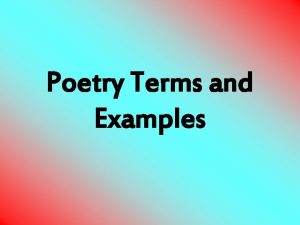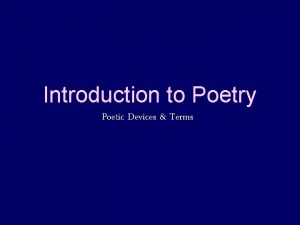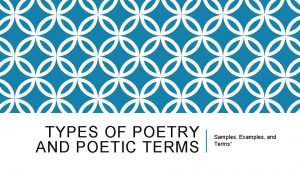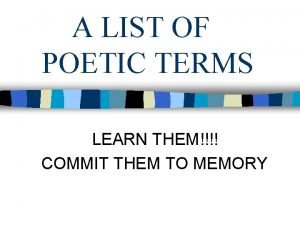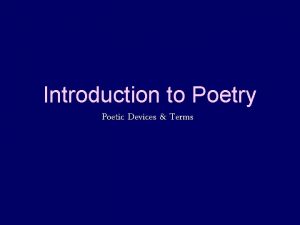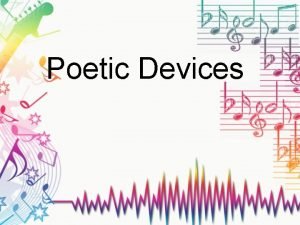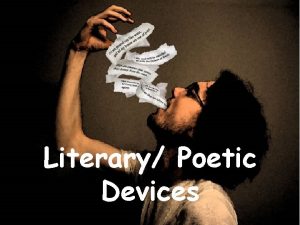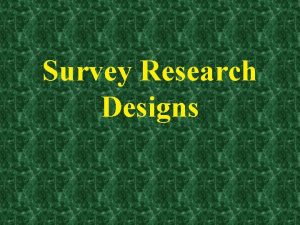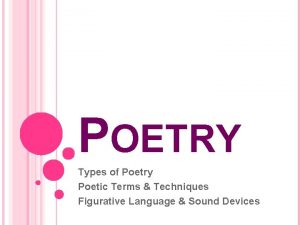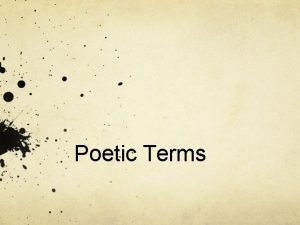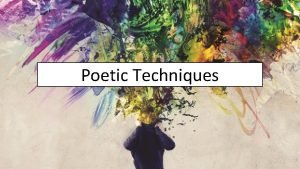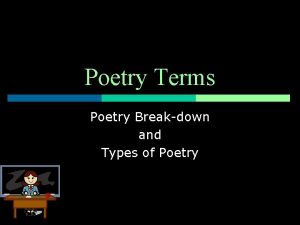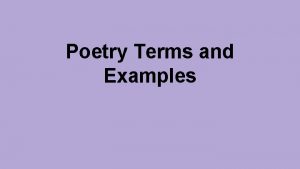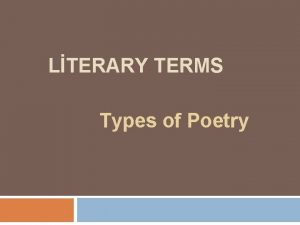TYPES OF POETRY AND POETIC TERMS Samples Examples










- Slides: 10

TYPES OF POETRY AND POETIC TERMS Samples, Examples, and Terms*

TYPES OF POETRY Ballads: The ballad means "dance songs. " Ballads usually tell a story, using four line quatrain stanza with an ABCB rhyme scheme where lines two and four rhyme. Some ballads have more than one quatrain. (Quatrain is four lines, especially one having alternate rhyming schemes). See: Langston Hughes’ “The Ballad of the Landlord. ”

TYPES OF POETRY Cinquain: A cinquain is a five-line poem. Line one has one word and is the title. Line two describes the title in two words. Line three uses three words to express action. Line four uses four words to express a feeling. Line five uses one word that restates the title. See sample cinquains.

TYPES OF POETRY Concrete Poetry – Verse that uses typeface and typesetting to convey meaning, such as the lines forming a shape on the page. See sample concrete poems.

TYPES OF POETRY Free Verse Poem: A free verse poem means that it does not follow any rigid rules of rhyme, pattern or meter. However, a great free verse poem will have some type of rhythm. It will also use poetic devices, such as metaphors, similes, personification, onomatopoeia, etc. See “Harlem” By Langston Hughes

TYPES OF POETRY Elegy An elegy is a sad, solemn poem written when someone dies, to lament for the person who died. A traditional elegy has three basic parts: an expression of grief, praise for the recently deceased, and then comfort and support. A couple famous elegies are, "O Captain! My Captain!" by, Walt Whitman and "In Memory of W. B. Yeats" by W. H. Auden.

REVIEW OF POETIC LANGUAGE AND LITERARY TERMS Imagery: The use of figurative language to create visual representations of actions, objects, and ideas in our mind that appeal to the physical senses. Writers use this type of figurative language helps us visualize their work. Similes and Metaphors: Both compare two distinct objects and draws similarities between them. Similes use “like” or “as” to compare and metaphors don’t. “Shine like a diamond” (simile) “He is a snake” (metaphor)

POETIC TERMS Repetition: Repeats the same words or phrases a few times to make an idea clear and to add emphasis. Symbolism: An object or action that stands for something more than its literal meaning. Ex. “All who wear white are pure and innocent. ” “She extended an olive branch. ”

POETIC TERMS Onomatopoeia: Words associated with sounds. Ex. Buzz, Clink, Zap, Plink, Boom. Rhetorical Question: Asked just for effect or to place emphasis on a point when no real answer is expected. Ex. “Did you want to see me broken? ” “Does my

Rhyme Schemes are represented by letters. Each letter in the Rhyme Scheme represents one line in the poem or story. Repeated letters indicate Rhymes. The Box shows an ABABCC Rhyme Scheme. This indicates that there are three rhymes in the Stanza. The Rhyme denoted by the letter A falls on the first and third lines and the Rhyme denoted by the letter B falls on the second and fourth lines. The Rhyme represented by C are the fifth and sixth lines. (Different letters occur when there is no corresponding rhyme for it. The letters
 Poetry terms and examples
Poetry terms and examples Peotic device
Peotic device Poetry terms with examples
Poetry terms with examples Like terms and unlike terms in polynomials
Like terms and unlike terms in polynomials How to combine like terms
How to combine like terms Poetic terms list
Poetic terms list Types of water sample
Types of water sample Noise day poem
Noise day poem Literary devices in introduction to poetry by billy collins
Literary devices in introduction to poetry by billy collins Literary devices in the jungle
Literary devices in the jungle Successive independent samples design
Successive independent samples design
